[Editor’s note: Following up on my analysis, in an earlier post, of the timing of Robert Capa’s arrival at and departure from Omaha Beach on the morning of D-Day, June 6, 1944, photojournalist and author J. Ross Baughman brings his experience as a combat photographer to bear on a frame-by-frame analysis of the 10 remaining images Capa made there. Part 2 appears below; click here for Part 1. — A. D. Coleman]
•
Battlefield Conditions on D-Day
during Robert Capa’s Coverage 6 June 1944 (continued)
•
What details about the Easy Red sector of the beach can be confirmed directly from Robert Capa’s photographs? The notes below take them in sequence, referring to them by their order on the contact sheet (CS) and the negative number visible on the film. An annotated version of the contact sheet appears at the end of these frame analyses.
CS frame 7/neg. 35:
Capa has relocated to the safety of Vehicle No. 10, and now pivots his camera back toward the sea, pointing north-northeast. Four troops share a very desperate position while lying prone on the wet sand, their single hedgehog affording almost no protective advantage against well-aimed enemy fire. Three small abandoned backpacks appear at the right, and in the foreground, two flotation belts lay discarded. In the background, a formation of three landing craft approaches the beach to deliver more troops in the Second Wave at 07:45 a.m. The photo is sharply focused on the soldiers.
Analysis: Despite orders to get off the beach as soon as possible, these men seem unable or unwilling to move forward. The Allied high command worried that continuous arrival of more landing craft would create a deadly bottleneck of troops that would have no chance for finding protective cover.
[Note, 1/28/16: Like almost everyone who has ever written about this image, I stand corrected in re its content. As Charles Herrick would subsequently demonstrate convincingly, these are heroic engineers going about their assigned task of blowing up obstacles so that vessels and vehicles will have a clear run to the beach. — J. R. B.]
[Technical note, 1/28/16: Slightly overexposed. Probably 1/50th of a second at f5.6. — J. R. B.]
•
CS frame 8/neg. 36:
Capa shoots essentially the same section of beach as in Frame 7, but from a slightly greater distance. The soldier at the far left has not moved, and seems to be in fine condition. The other soldiers have hugged closer to the sand, and could possibly be wounded. In the background we see the progress of the same approaching landing craft.
[Note, 1/28/16: As indicated immediately above, I stand corrected in re the content of this image. — J. R. B.]
[Technical note, 1/28/16: Probably 1/125th of a second at f5.6. Slightly overexposed. — J. R. B.]
•
CS frame 9/neg. 37 [which would have been marked on the film as 37, although this original negative is missing]:
Capa describes joining the troops huddled behind “a half-destroyed amphibious tank” [Vehicle 10, seen in Frames 3-5, negs. 31-33], and it is clearly from this vantage point that he looks back towards the sea and spots Huston Riley. The facts of the water’s depth and the last row of hedgehog obstacles appearing in the background pinpoints Capa’s position. Riley describes Capa heading immediately back into the sea to board a large hospital ship that had just pulled up onto the beach, at about 07:50. Capa’s total time on the ground could be as short as 20 minutes, and no more than 30.
[Technical note, 1/28/16: also underexposed, as much as the first frame — by about 1.5-2 stops. Minimal highlight detail. Probably 1/125th of a second at f8. Maximum camera motion. — J. R. B.]
•
CS frame 10/neg. 38:
Capa heads back to the water’s edge, seeing the same part of the beach defenses that he shot in Frame 6. Four soldiers can be seen hiding behind various wooden obstacles.
[Technical note, 1/28/16: Second view of the diagonal obstacles. Probably 1/125th of a second at f5.6. Slightly overexposed. — J. R. B.]
•
Final Analysis: For the American, Canadian, British and Free French forces, the invasion of Normandy on 6 June 1944 was the longest and most important day up to that point in the war. A picture editor in London for LIFE magazine could only hope first and foremost that the six photographers he sent off to cover D-Day wouldn’t die trying. None of them did.
Beyond that, a picture editor could only try to arrange a front-row seat for each camera. Whatever fate fell upon those scattered military units, at least each photographer would have shared in that experience seamlessly.
Did the quality of photographs Capa turned in from D-Day earn him a promotion, raising him up from contract photographer into a full staffer at LIFE? Only if his late, thin package of prints benefited from a most extraordinary salesmanship. Based on that all-important assignment, I would have been hard-pressed to give him another chance. I might have turned instead to some enthusiastic 18-year-old fellow trapped back in the darkroom, like Larry Burrows. I wonder if he was ready, and how he might have handled a trial by fire.*
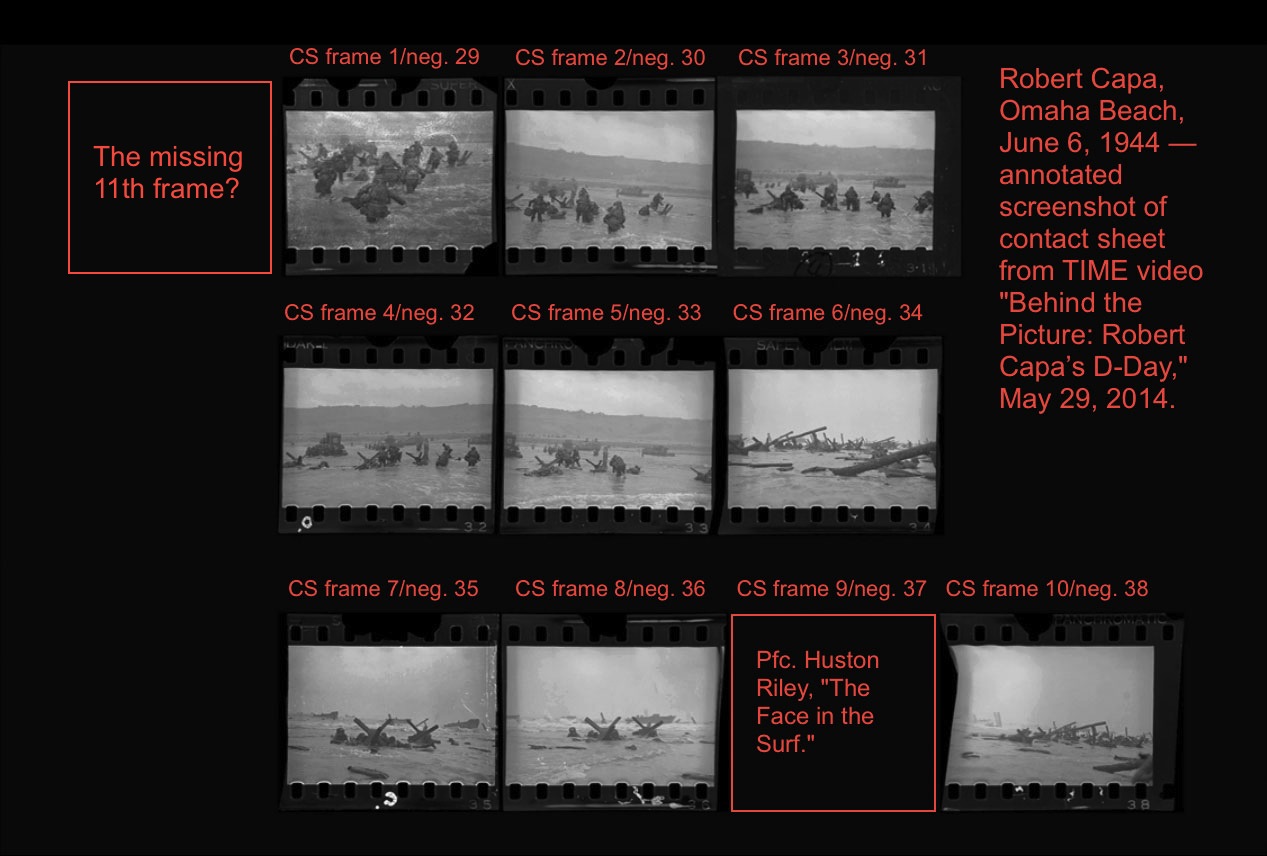
Robert Capa, D-Day images from Omaha Beach, contact sheet, screenshot from TIME video (May 29, 2014), annotated.
[*Note, July 30, 2015: I have just become aware, for the first time, of the parallel analysis published — in Dutch only — in December 2012 by a Dutch researcher, Pieter Jutte. My key issues have always been rooted in the film-processing fraud, the timeline on the beach, and the impossibility of Capa arriving in the first wave — crucial matters to which Jutte seems oblivious. I concentrate on Capa’s failures to cover the battle adequately and to get the film back to LIFE‘s London office in a timely manner, and then on how he concocted or accepted excuses, smearing and throwing blame on others. Unwisely, Jutte bases much of his interpretation on uncritical acceptance of Capa’s narrative. Some echoes occur between his analysis and mine because we both walked through the same ten photos, highlighting elements thereof, but Jutte didn’t even get the sequence of Capa’s negatives correct on that: he has “The Face in the Surf” positioned as the eighth of Capa’s ten exposures (it’s the ninth), and the image of the demolition team at work as the tenth, when it’s the seventh. — J. R. B.]
•
Omaha Beachhead on D-Day: A Summary
Omaha was divided into ten beaches, codenamed (from west to east): Able, Baker, Charlie, Dog Green, Dog White, Dog Red, Easy Green, Easy Red, Fox Green and Fox Red. Capa attached himself to the hundred men of Easy Company, assigned to the 2nd Battalion, which also had two other rifle companies, and together they joined the assault on the Easy Red section of Omaha Beach.
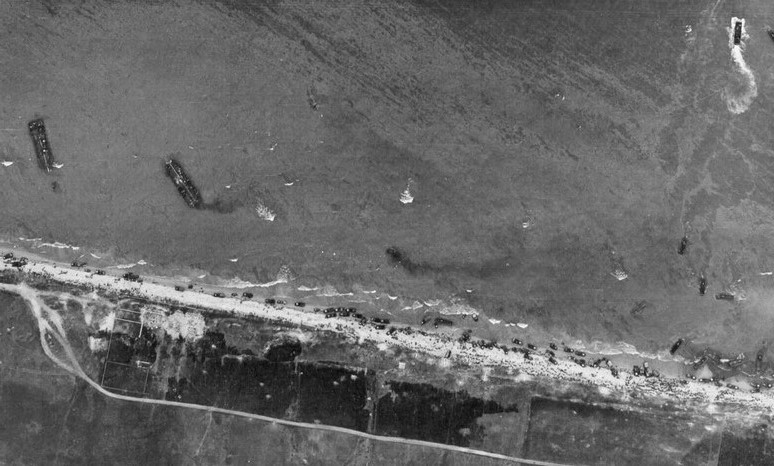
Aerial view of Omaha Beach, Normandy, France, taken 6 June 1944, showing landing of two infantry regiments, 18th and 115th, vehicles, and landing craft. Photo by U.S. Army, courtesy U.S. National Archives.
The first wave landings were scheduled to start at 06:30, “H-Hour,” on a flooding tide, preceded by a 40-minute naval and 30-minute aerial bombardment of the beach defenses, with the DD tanks arriving five minutes before H-Hour, although very few of the special floating armored vehicles made it to shore.
Those troops arriving at 06:30 were combat engineers assigned to clear the obstacles on the beach, and these were followed 30 minutes later by the rifle companies. Only five of the 16 engineer teams arrived at their assigned locations, but some of their most effective work took care of a wide swath on the eastern half of Easy Red.
Very little else went according to plan. Ten landing craft were swamped by the rough seas before they reached the beach, and several others stayed afloat only because their passengers baled water out with their helmets. Seasickness was prevalent among the troops waiting offshore.
The infantry were organized into specially equipped assault sections, 32 men strong, one section to a landing craft. The continuous arrival of reinforcements every 15 minutes meant that clearing the tank traps, land mines and other obstacles was the first priority. The crucial order repeated again and again to all of the infantrymen was “Get off the beach. If you stay there, you’ll be in the killing zone.”
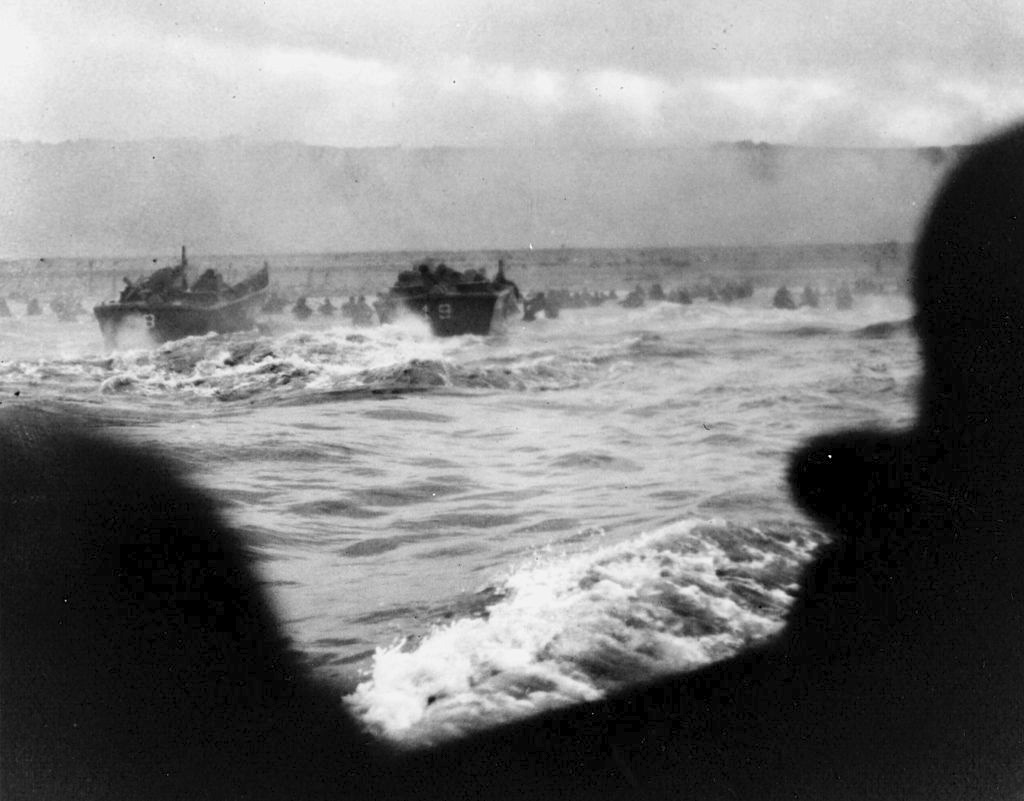
Robert Sargent, U.S. Coast Guard First Photographers Mate, “Landing craft put troops ashore on Omaha Beach,” first wave, 6-6-44. Courtesy National Archives.
Capa’s unit arrived on one of the 81 Higgins boats officially designated as LCVPs, although with the alphabet-soup of military abbreviations, these were commonly misnamed as LCI, which actually described a larger craft. Once the front ramp came down, all the troops trained to debark their landing craft in 19 seconds, according to studies from the War Department. The entire armada servicing Omaha Beach consisted of 2 transport ships; 6 Landing Ships, Tank (LSTs); 53 LCTs; 5 Landing Craft Infantry (Large) (LCI/(L)s); 81 LCVPs; 18 LCAs; 13 other landing craft; and about 64 DUKWs.
Where the naval bombardment had set grass fires burning, as it had at Dog Red opposite the Les Moulins strongpoint, the smoke obscured the landing troops and prevented effective fire from being laid down by the Germans. Another decisive factor was the natural layout of the beach. At those exits off the beach known as the draws, Germans had concentrated their toughest defenses. Allied troops landing near them quickly wound up in no shape to carry a further assault.
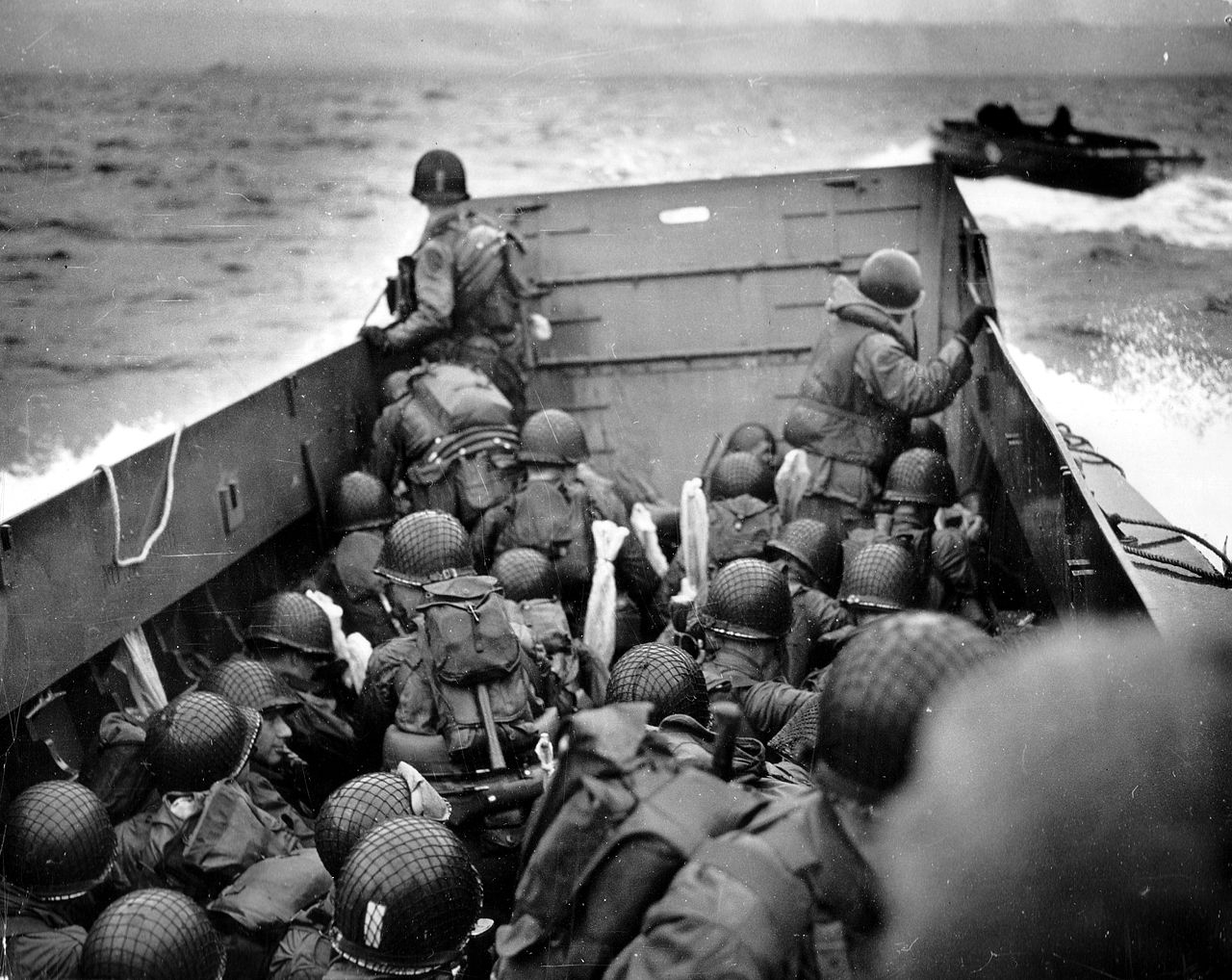
An officer observes Omaha as his landing craft approaches the Norman coast. Photo courtesy U.S. National Archives.
Only in the areas between the draws, at the bluffs where Capa’s unit landed, were troops able to land in greater strength. The eastern end of Easy Red, was an area between strongpoints. Most of the 63 casualties for the day came before they had reached the inland edge of the beach.
Those scattered sections landing at Easy Red encountered a deep runnel after being landed on a sandbank, and were forced to discard most of their weapons to make the swim ashore.
“Are you going to lay there and get killed, or get up and do something about it?” came the challenge from one unidentified lieutenant on the Easy Red section of Omaha Beach.
Scattered elements of three companies were reduced to half strength by the time they gained the relative safety of a sand berm known as “The Shingle,” because its steep angle resembled the side of a roof. Many of these combat engineers had crawled the 300 yards of beach just ahead of the incoming tide.
Survivors at the shingle, many facing combat for the first time, found themselves relatively well-protected from small arms fire, but still exposed to artillery and mortars. In front of them lay heavily mined flats exposed to active fire from the bluffs above. Morale naturally became a problem. Many groups were leaderless and witnesses to the fate of neighboring troops and landings coming in around them.
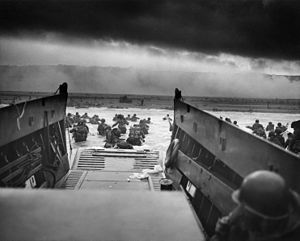
“Into the Jaws of Death,” photo by Chief Photographer’s Mate Robert F. Sargent. Assault craft land one of the first waves at Omaha Beach, Company E, 16th Infantry, 1st Infantry Division. Courtesy National Archives and Records Administration.
The second and larger wave of assault landings brought in reinforcements, support weapons and headquarter elements at 07:00 only to face nearly the same difficulties as had the first. The only advantage enjoyed by second wave was that it was larger, and so the defenders’ fire was less concentrated.
The survivors of the first wave were unable to provide effective covering fire, and in places the fresh landing troops suffered casualty rates as high as those of the first wave. Failure to clear enough paths through the beach obstacles also added to the difficulties of the second wave. In addition, the incoming tide was beginning to hide the remaining obstacles, causing high attrition among the landing craft before they had reached the shore.
Between 07:30 and 08:30 elements of Easy Company came together and climbed the bluffs at Easy Red, between German bunkers designated WN-64 (defending the E-1 draw) and WN-62 (the E-3 draw).
Led by Second Lieutenant John M. Spalding and Captain Robert L. Sheppard V, Easy Company turned westward along the top of the bluffs, engaging in a two-hour battle for a German bunker designated WN-64. His small group of just four men had effectively neutralized this point by mid-morning, taking 21 prisoners — just in time to prevent them from attacking freshly landing troops. On the beach below, the 16th RCT commander, Colonel George Taylor, had landed at 08:15, with the words “Two kinds of people are staying on this beach, the dead and those who are going to die — now let’s get the hell out of here!”
At 09:05, German observers reported that the key bunker WN-61 was lost.
[This account of the landing was assembled from multiple articles on Wikipedia and elsewhere, but primarily from Wikipedia’s “Omaha Beach.” — J. R. B.]
•
(Click here for Part 1. For an index of links to all posts in this series, click here.)
(To see all of Capa’s D-Day images at the Magnum website, click here.)
•
In 1978, at the age of 23, photojournalist J. Ross Baughman became the youngest professional ever awarded the Pulitzer Prize, and was cited for his coverage of the guerrilla war in southern Africa. While continuing to work that same year as the first contract photojournalist ever hired by the Associated Press, he competed against himself with two other nominations: For infiltrating the American Nazi movement over nine months to uncover their assassination and bombing plans and once more for being the first journalist to ever accompany Palestinian commandos operating behind Israeli lines.
Baughman soon went on to become an international lecturer on journalism ethics, a university professor and founder of the photo agency Visions, which specialized in long-term, high-risk, difficult-access investigative photo essays around the world. Besides covering wars in 11 countries, his work has appeared everywhere from LIFE to Vanity Fair, Newsweek, Time, Stern, The New York Times Magazine and Vogue.
Some of his writings and photographs may be seen at Wikipedia and at his own website. For his previous Guest Post, click here. To contact J. Ross Baughman, click here.


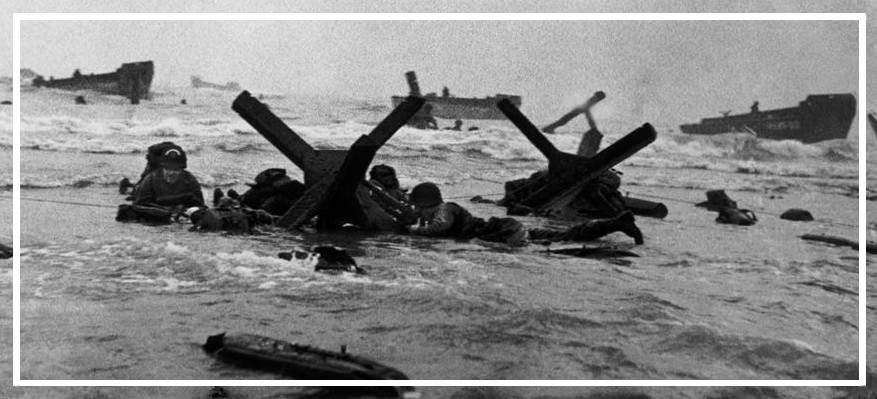
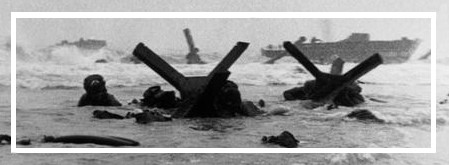
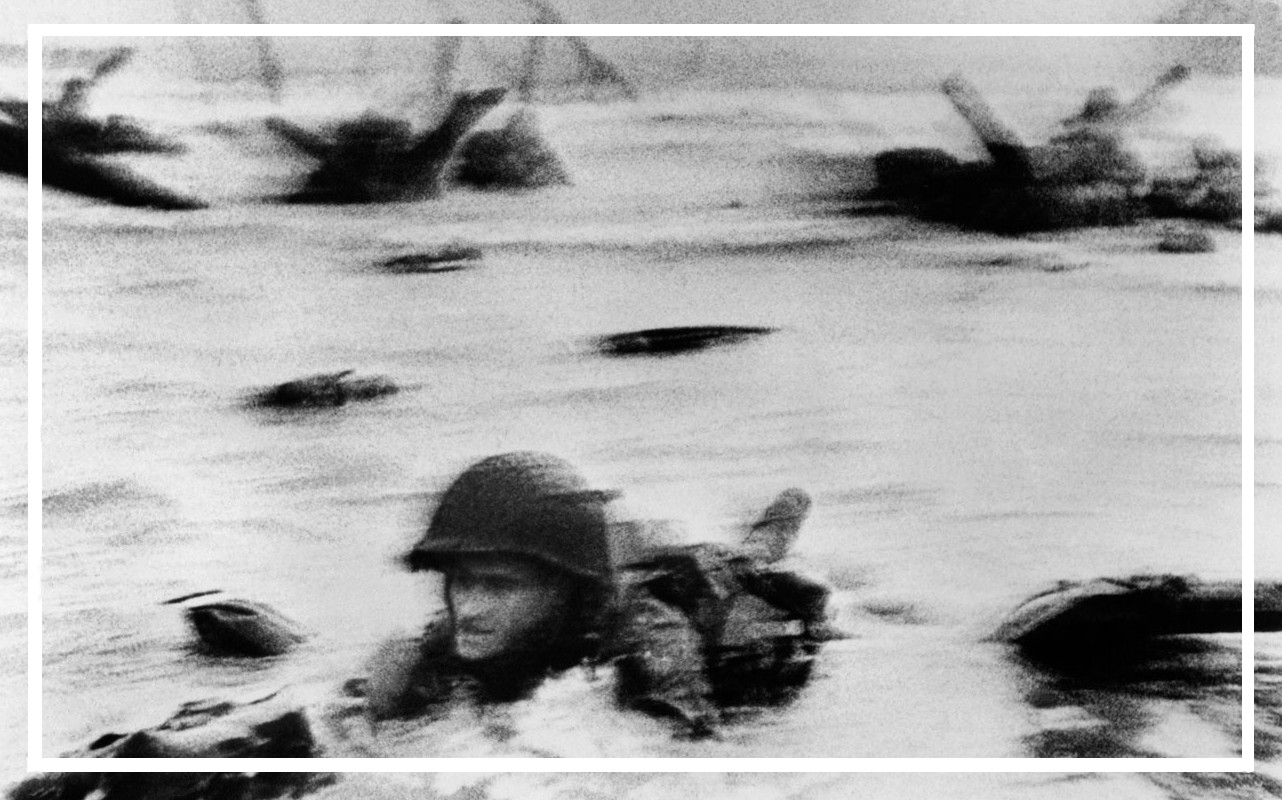
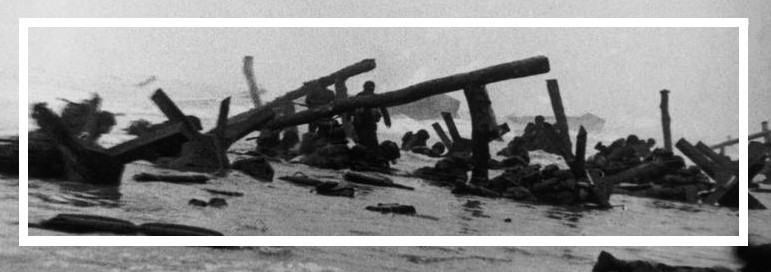
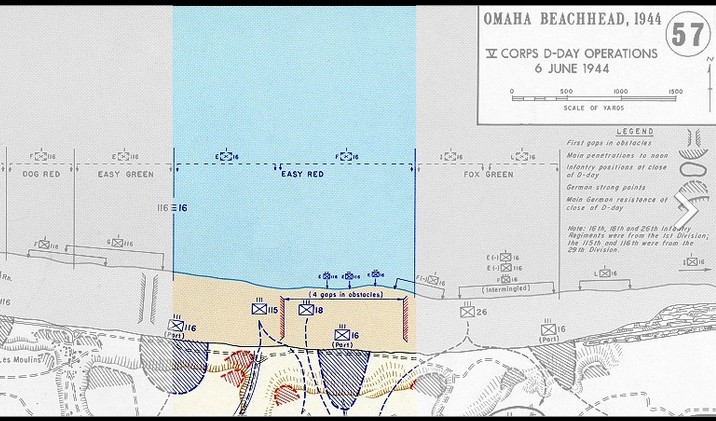





Ross and Allan,
I have always felt John Morris got it wrong, there are not 11 frames. By the count of the Time video, there are frames 29-38 which may include the missing famous one. If there was on more beach landing frame, as you point out, it would have to be before or after the frames we know. I once looked at the contact sheet, when I was worked in the Life Picture Collection. on the same sheet, with individually cut frames, there were some other images of soldiers on land, not in water, casually standing around or walking, not under danger, maybe made the next day? or whenever Capa came back, BUT there are ONLY the nine frames, same ones that are in the video, without the missing famous one. Already lost by time contact made or kept somewhere else? And, by the way, the same frames as on the Magnum website.
Best wishes always, Robert Stevens
Thanks for this info. As a former TIME picture editor, you’ve had a chance to see material not accessible to the rest of us.
The annotated contact sheet we include in our posts show the 9 surviving negatives, with a placeholder inserted for no. 37 (“The Face in the Surf” — Pfc. Huston Riley) between 36 and 38, the only logical place for it. The negative went missing long ago; presumably all subsequent prints get made from a copy negative, one made either directly from the original negative or from an original print made from it at the time.
Various anecdotes about the second missing negative suggest that it was either damaged or else duplicated another so closely as not to warrant reproduction. Careful scrutiny of the contact print of neg. 38 and the blank film segment after it indicates that it most probably was the last exposure on that roll. So the missing negative would have had to come at the start of the sequence, no. 28, for which we included a placeholder also. It might have shown roughly the same scene as the first surviving negative: Easy Company infantry disembarking from their Higgins boat. Since negative 29 shows the last of those 32 soldiers entering the water, its predecessor would likely have shown the first or second batch to do so.
Sir,
My compliments on your analysis of these photos. Very instructive. May I offer, however, a different interpretation of the events in negatives 35 and 36?
Several years ago I analyzed these photos and noted a few additional key details. Taking negative 35 for example, it is clear they are not seeking cover at the hedgehog. One soldier is plainly in front of it and another too far to the rear to profit from it.
Note also the white arc stenciled on the front of the helmet on the man to the left, staring at the camera. That is an ETO helmet marking designating an engineer. A close look at the photo discloses another helmet marked so, worn by the man who is partially obstructed by the hedgehog on the right side. This is a group of engineers, and from the body language of three of them, they are concentrating on some vital task behind and near the base of the hedgehog.
The clue to their concentration is the barely visible line that cuts across the photo from the left side to the base of the hedgehog in the center-left foreground, and then on to the hedgehog in the center-right foreground, and then stretches off to the right and out of the picture.
What we have here are engineers proceeding calmly (as possible) with the task of blowing gaps in the beach obstacles. They are in the process of connecting charges at multiple obstacles for a simultaneous detonation, what was termed a ‘shot’ in the business. The line in the picture is actually Primacord, a WWII version of det cord, which would transmit the detonation from charge to charge.
Looking in front of the landing craft in the middle background, we see two more men on the ‘wrong’ side of a pole charge. Comparing their actions in negatives 35 and 36, it seems clear they are rigging that obstacle for detonation as well. We see all the indications of an organized engineer effort underway, despite the hostile fire.
It is worth noting that here on Easy Red they had the most effective lane breaching of D-Day. Although 16 lanes were to have been blown along the length of Omaha, only six complete and 3 partial breaches were actually blown. No fewer than four of those six were completed right there on Easy Red where Capa took these shots. Those breaches provided the sole ‘safe’ access to Omaha in the first 9 hours, and probably were decisive in tipping the balance. And these photos capture the brave men who worked the miracle.
Engineer efforts are captured in a couple of Capa’s other photos as well, such as the dozer tank with its attached demolitions trailer, and the engineer inflatable boat – sitting just above the waterline – in which the first waves of engineers brought in their demolition equipment.
In short, far from being unwilling to move forward under fire, we see dedication, discipline and raw courage. While many soldiers did huddle in the surf that day, enough stuck to their jobs to make the invasion succeed. Once you recognize the patterns, sometimes that which appears to be chaos in fact makes perfect sense. Not that there wasn’t enough real chaos that day …
I’ve often thought it a shame that brave men such as these (as a group, they had the highest casualty rate on Omaha) should become instead the visual symbol representing failure of nerve on 6 June 1944. They deserve better.
Regardless, thanks for the otherwise great analysis. I enjoyed it.
I greatly appreciate your skills of observation, and the added familiarity with military history that you add to our analysis. Please contemplate the time when frames 35 and 36 were taken, being over 60 minutes after the combat engineers first landed. While I don’t doubt the clues you have recognized about their task at hand, what do you make of the fact that they are still working on demolition at the water’s edge? Do the relatively exposed positions they have taken suggest that they were not at that moment trying to better shield themselves? My own guess is that nearly all German small arms fire was concentrated on the Allied troops who had already crossed the beach and were threatening them at much closer range.
Sir,
I noticed that my name is in this story. It was brought to my attention by Chuck Herrick who was busy with the picture of Omaha, shot by Capa. When I wrote my page on this subject, I had little more to go on then the famous pictures, I din’t even know the sequence (this is corrected by the way). Chuck has his doubts concerning the disembarkment of Capa at Omaha Beach. I go also into this subject, but I have my own theory. It is still a work in progress, and it will no doubt change in the future when more will come to light during the research by Chuck.
I visited the sector where Capa landed this September again, during high and low tide, just to check the surf with the pictures. Also the angles the shot were taken, in comparison with the famous picture by Sargent, who went later in to the same sector (when the hill was obscured by the smoke, and he was closer to the beach), he shot his pictures from a somewhat higher angle, just a feet or two perhaps, and gets the same amount of beach as Capa, which suggests that Capa could have arrived in the same time slot as Sargent (no, the smoke on the hill shows that Sargent came much later).
As I say, it is an ongoing process, but I see Capa as a dare devil who did not expect to land in hell and horror when he embarked for France: http://www.strijdbewijs.nl/robert/capa1.htm
Thank you for your comment. Charles Herrick footnoted your research in his September 23, 2015 post analyzing Capa’s probable landing point. Perhaps you can review that and let us know if you have new information to add.
As you’ll see if you read Herrick’s new post, Capa landed at a location where enemy fire was relatively sparse at the time of his arrival at the tail end of the second wave. Like Herrick, I do not mean to trivialize any volume of fire, nor the bravery it takes to face it. But Capa certainly did not encounter anything like the “hell and horror” that others experienced elsewhere on Omaha Beach, or that he himself describes in his fictionalized memoir.